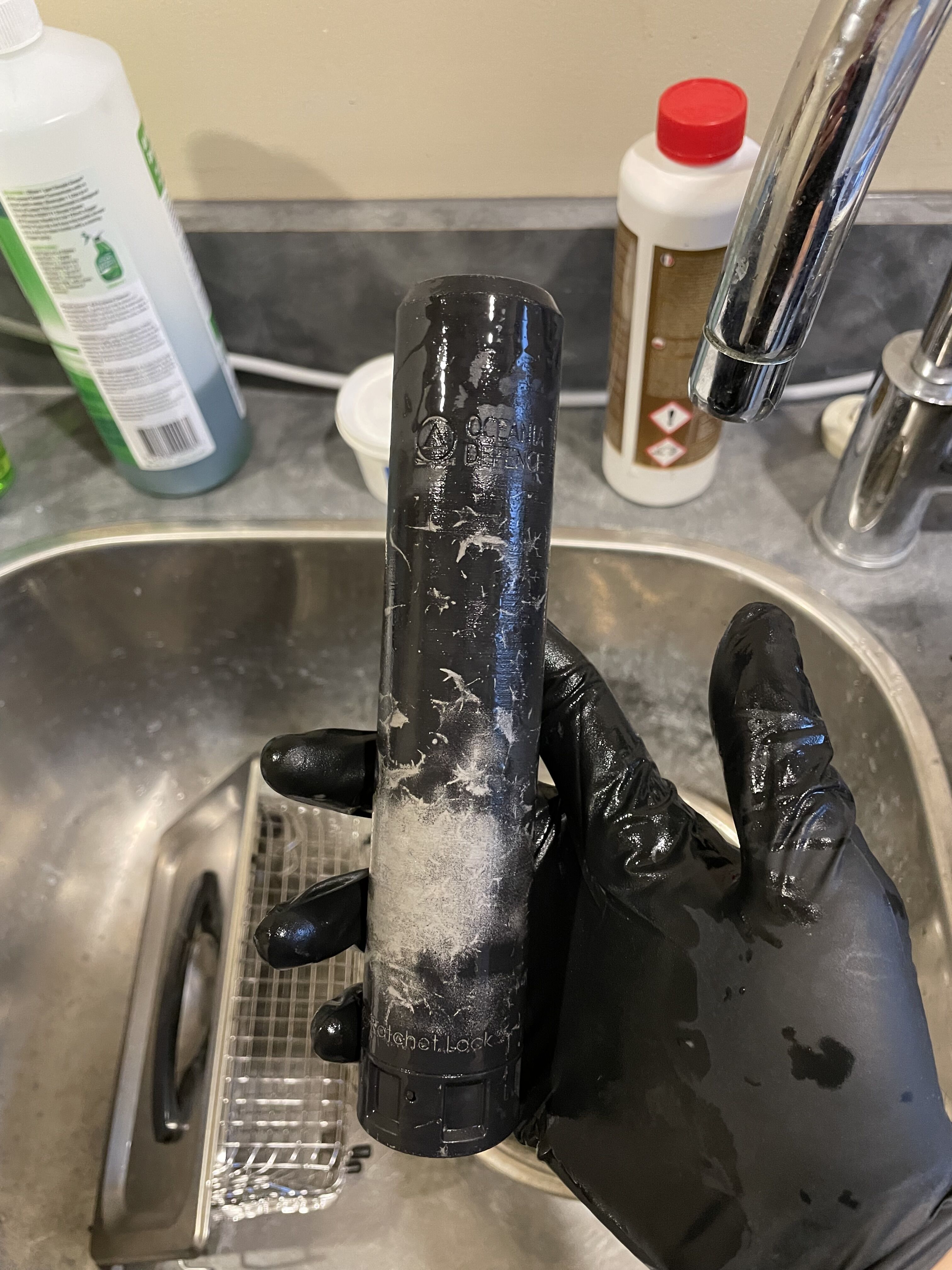You shouldn't need a proprietary cleaner, they are expensive bullshit. Almost always a simple product marketed well. I'd be amazed if two cycles through the ultrasonic with simple green is still not good enough
Welcome guest, is this your first visit? Create Account now to join.
Welcome to the NZ Hunting and Shooting Forums.
Search Forums
User Tag List
+ Reply to Thread
Results 16 to 27 of 27
-
08-04-2024, 05:41 PM #16Member

- Join Date
- Mar 2018
- Location
- Turangi
- Posts
- 1,373
-
-
08-04-2024, 05:55 PM #17Banned

- Join Date
- Mar 2024
- Location
- west coast N I
- Posts
- 625
Flood it with carb cleaner or Brake kleen? Shake , rattle and roll repeatedly , then flush with hot soapy water ?
Ultrasonic cleaner with heat should do the job.
-
08-04-2024, 06:44 PM #18Member

- Join Date
- Dec 2021
- Location
- Tauranga
- Posts
- 5,877
Probably got a thick enough coating inside that it's bridged over the internal surfaces - the carbon needs to break up and flake off to clean the thing. Carbon is relatively non reactive, especially when it has a mechanical bridge locking it in place. Ultrasonic will be the solution along with time and a solution that is as strong as you can go without stuffing the surface or leaving a flammable residue inside. An alkali oil remover like you'd find in a workshop parts cleaner might be the go???
-
08-04-2024, 06:51 PM #19
nobody has suggested a small bottle brush yet....interesting as a slightly oversized bore brush does wonders for the flakey wee bits....
agree to ask the fellas who made the thing75/15/10 black powder matters
-
08-04-2024, 07:30 PM #20
CLR is acidic, iron steel, duralim won't like it. An idea carbon has a different expansion rate than metal heat the whole suppressor to about 100 degrees ( you may have shot it that hot or hotter at times) then drop it into cold detergent solution and straight into the ultrasound.
-
08-04-2024, 07:45 PM #21Member

- Join Date
- Mar 2016
- Location
- Waikato
- Posts
- 443
Patch out accelerator dissolves carbon very effectively. I’d fill the can with some in a zip lock and put it in the ultrasonic. That’s how I’ve been cleaning my take apart suppressors. They come out pretty spotless.
-
11-04-2024, 06:08 PM #22Member

- Join Date
- Sep 2013
- Location
- Wairarapa
- Posts
- 1,396
Another option to consider carefully but may work if done correctly would be to fill the suppressor with a substance and some gently abrasive material like small ball bearings, or small stainless steel screws.
With each end plugged, sit it in a couple of rollers and set one up so it spins slowly enough for the abrasive material to not be forced outward by centrifugal force.
As it slowly spins, the ball bearings roll over the carbon deposits and chip away at them. A little bit like a wet brass tumbler.
-
12-04-2024, 10:16 AM #23Member

- Join Date
- May 2019
- Location
- Christchurch
- Posts
- 313
Here are some feedback based the experiment I did last night.
Schletek Suppressor Cleaner -> Not really useful against heavy carbon deposit.
Simple green + 2 hours of ultrasonic cleaning -> It actually works better than the solution. It shakes the carbon flakes from the deposit, some, but not all.
There are still visible carbon deposits inside of the suppressor. I guess I need to keep using the ultrasonic cleaner for a while now.
-
12-04-2024, 12:38 PM #24Member

- Join Date
- Jun 2022
- Location
- Papakura
- Posts
- 1,601
Keep going with the ultrasonic and maybe as longshot said use some media like stainless pins if it's still stuborn
-
12-04-2024, 01:01 PM #25Member

- Join Date
- May 2019
- Location
- Christchurch
- Posts
- 313
Tumbling with media will damage the finishing on the outside, for which I'd try to avoid. -- Although the cerakote already started peeling off due to the ultrasonic cleaning.
-
12-04-2024, 06:07 PM #26Member

- Join Date
- May 2019
- Location
- Christchurch
- Posts
- 313
Just FYI, the cerakote finish will be damaged from ultrasonic cleaner.

-
12-04-2024, 07:32 PM #27Member

- Join Date
- Aug 2023
- Location
- WA
- Posts
- 694
Said it before but hey don't listen acetone it
Similar Threads
-
Using a sealed Titanium Suppressor for Rimfire - cleaning?
By 308mate in forum Firearms, Optics and AccessoriesReplies: 8Last Post: 11-08-2019, 07:47 PM
Tags for this Thread
Welcome to NZ Hunting and Shooting Forums! We see you're new here, or arn't logged in. Create an account, and Login for full access including our FREE BUY and SELL section Register NOW!!





 16Likes
16Likes LinkBack URL
LinkBack URL About LinkBacks
About LinkBacks



 Reply With Quote
Reply With Quote


Bookmarks